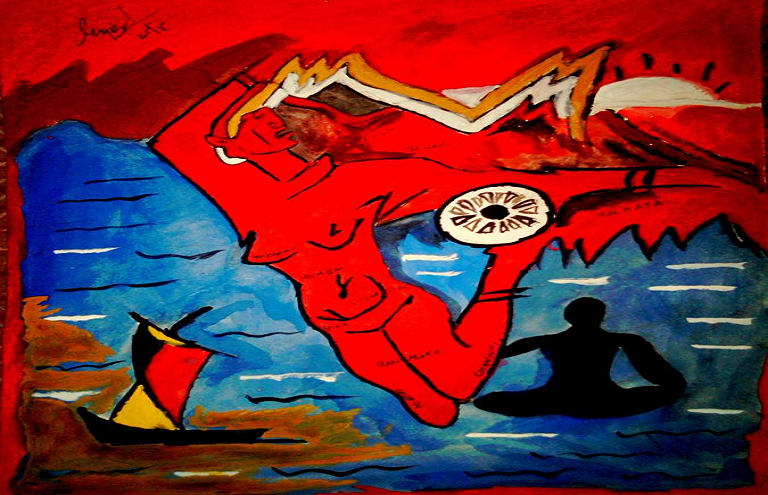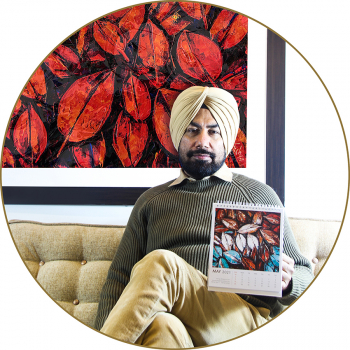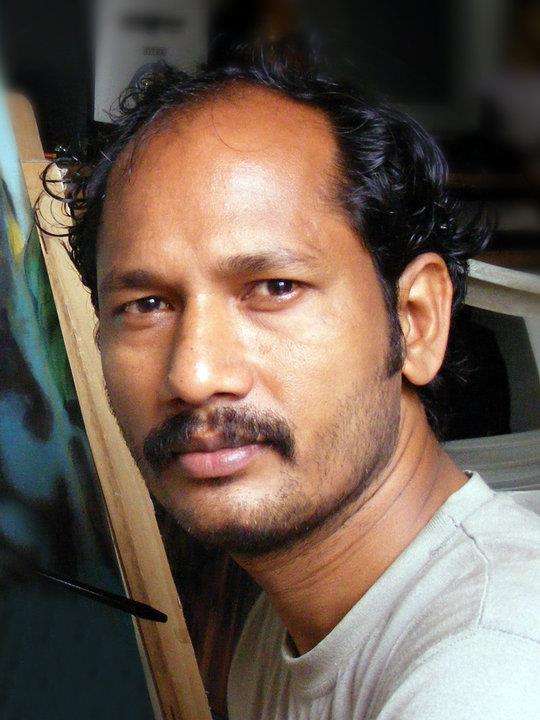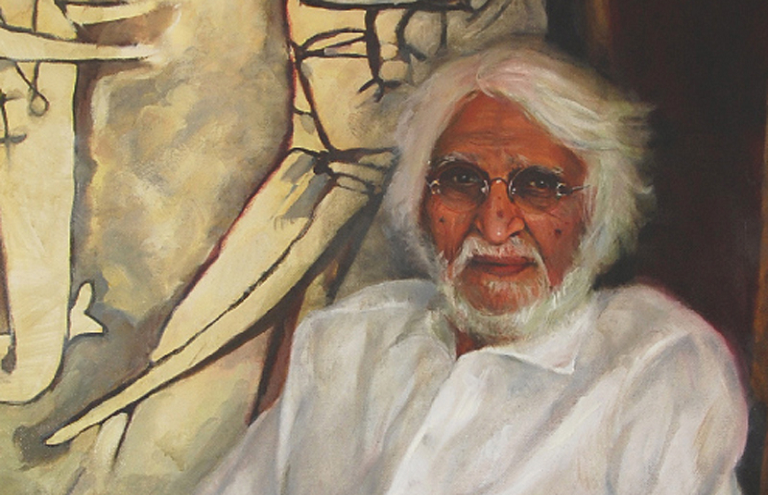
The most celebrated Indian artist of the 21st century, Maqbool Fida Husain, popularly known as MF Husain has always been a towering figure of admiration but also constantly mired in controversy. Often hailed as the ‘Picasso of Indian Art’ the prolific artist earned international fame and recognition for his remarkable career, undying enthusiasm, spurts of energy, and an expansive and dramatic oeuvre. He passed away at the age of 95 on June 9, 2011 in London, but still continues to dominate the imagination of artists and the canvases of Indian artwork.
Husain’s extraordinary life and exceptional career have much to do with his humble beginnings. Born in 1915 to a traditional Muslim family in the Pandharpur region of Maharashtra, he was fascinated towards art right from his childhood. He lost his mother when he was only a year old, and all his life longed for the love and warmth of a mom. Many of his paintings that now adorn the most prominent Indian art gallery were his attempt to find solace and fill up the maternal absence in his life.
Dabbling in Urdu poetry classes and painting lessons in the evening, Husain grew up with limited formal education. His childhood and early years were marked by genteel poverty, frequent shifting of places, and an irregular, informal education under the guidance of an Islamic scholar. Later due to financial needs his father assigned him to be a tailor’s apprentice. But drawn to art, he went to Mumbai to study art at the JJ School of Arts.
He finally moved to the city of Mumbai in the 1930s, as a young adult and took up the job of a cinema hoarding painter. Apart from painting the billboards, he also worked for a toy company where he was involved in designing and building toys, to earn extra income.
Later in 1947, his career took a significant turn after Francis Newton Souza invited him to join the revolutionary Bombay Progressive Artists' Group (PAG). Founded by the iconic Indian artists like Francis Newton Souza and S.H. Raza, this group rejected the traditional styles of painting and attempted to change the entire landscape of Indian art history by combining Indian art history with new and modernist styles. The beliefs and works of this group significantly impacted the practices of Husain wherein he developed his own modernist vocabulary.
After this Husain and other artists got many opportunities to exhibit his artworks in Mumbai and by the 1950s, he garnered international fame. With Souza moving to London, and Raza making his career in Paris, PAG eventually dispersed. But Husain decided to stay in India and went to become a household name that was synonymous with Indian modern art, with his signature sketches finding a place on restaurant walls and textiles.
Owing to his love for cinema, admiration for Bollywood actors often reflected on his canvases. Particularly charmed by the famous Indian actress, Madhuri Dixit, Husain not only created paintings featuring his muse but also to launch his own film ventures directing Madhuri Dixit in ‘Gaja Gamini’ (2000) and later roped in Tabu, impressed by her timeless beauty, in his movie titled ‘Meenaxi: A Tale of Three Cities’ in 2004. He also had plans to make films with other Bollywood divas including Urmila Matonndkar and Vidya Balan. He also took a keen interest in politics and attended sessions of parliament for six years but never spoke rather spent time sketching.
He was honoured with numerous awards and accolades for his remarkable contribution to art in his lifetime, both in India as well as across the globe. In India, he was conferred with the all the three civilian awards of Padma Shri in 1955, Padma Bhushan in 1973 and Padma Vibhushan in 1991. Talking globally, he won a Golden Bear Award at the Berlin Film Festival in 1967 for his early cinematic experiment ‘Through the Eyes of a Painter,’ and later in 1971, he was invited to display his artworks alongside those of master artist, Pablo Picasso at the prestigious São Paolo Biennale.
Here are some of the incredible creations of the maestro that became the most talked about Indian artworks:
Battle of Ganga and Jamuna
Based on Hindu mythology which established a connection between Ganga and Yamuna, this painting represents the battle between right and wrong, a dilemma that we often encounter in our everyday lives. From the Mahabharata series, this oil on canvas art is one of most prolific paintings created by Husain. Completed in 1971, ‘Battle of Ganga and Jamuna’ fetched a whopping amount of nine crores INR in auction at Christie’s where it was placed alongside other remarkable paintings for sale.
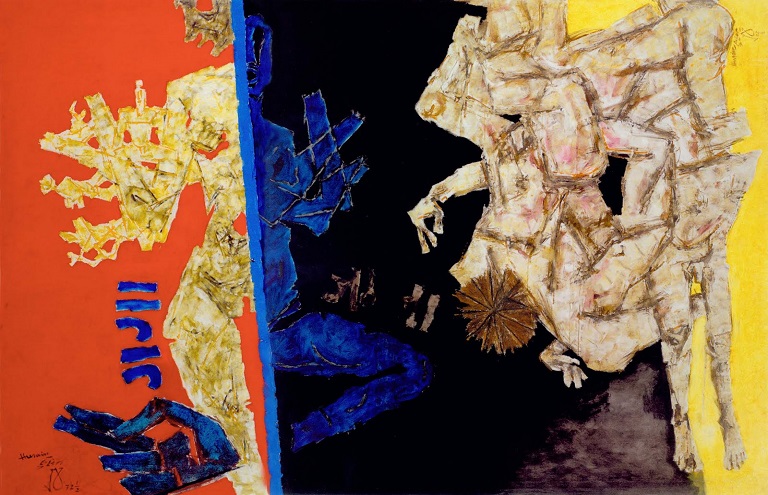
That Obscure Object of Desire
A diptych painted in the 1980s went on sale for a staggering 2.5 crores INR at Sotheby’s Modern & Contemporary South Asian Art sale in New York. Inspired by the 1977 film by Luis Buñuel titled That Obscure Object of Desire, this melancholic work attempts to highlight the pain of unfulfilled desires. It depicts fragmented figures unanchored from a landscape featuring pale earth and a dark sky.
Mother Teresa
Captivated by the aura of many famous personalities, Husain painted many such figures in his artworks. He explored the notions of the venerated figure of Mother Teresa in his numerous canvases. From 1980 onwards, Husain painted over 18 canvases dedicated to Mother Teresa which reflects the profound impact her life and work had on him. In almost every painting from the Mother Teresa series, depicting the Christian saint as a faceless entity, he attempts to explore motherhood that he has always longed for and highlight the inner beauty of the saint. However, while creating this series, he has significantly borrowed elements from Renaissance art styles, incorporated the pointed arches of cathedral architecture in his every painting from the series. Even his handling of clothing, where he has depicted the drapery and the folds of the ecclesiastical robes of Mother Teresa is inspired by the 15th century Italian painting style preoccupied with realism.
Cinq Sens (Five Senses)
‘Cinq Sens (Five Senses)’ is an oil on canvas painting created by Husain in 1958 for popular Italian film director Roberto Rosellini and his Bengali wife. Featuring excellent brushstrokes and brilliant use of bold colors, this painting became one of the most expensive artworks of Husain, it was auctioned for around 3.6crore INR at Sotheby’s in 2010.
The Sixth Seal
Painted in his signature cubist modern style, this important artwork from 1964 exemplifies the most important symbols and themes of Husain. With its canvas made up of six vignettes, with each composition manifesting the traditional forms of Indian sculptures, dance, folk art and the ancient miniature paintings. Interestingly, unlike most of his works from this time, there appears to be a narrative between some of the vignettes of this painting. The central seal features a figure giving birth wherein it is flanked by five other vignettes depicting the Goddess Ganga, few galloping horses, a portrait of a bearded sadhu (many call it to be a self portrait), a series of folk heads, and a human hand performing the Abhayamudra, the fear abating gesture. ‘The Sixth Seal’ was one of the last of his paintings for sale, it went for auction at Sotheby’s during his life in May 2011 fetching approximately 3.7crore INR.
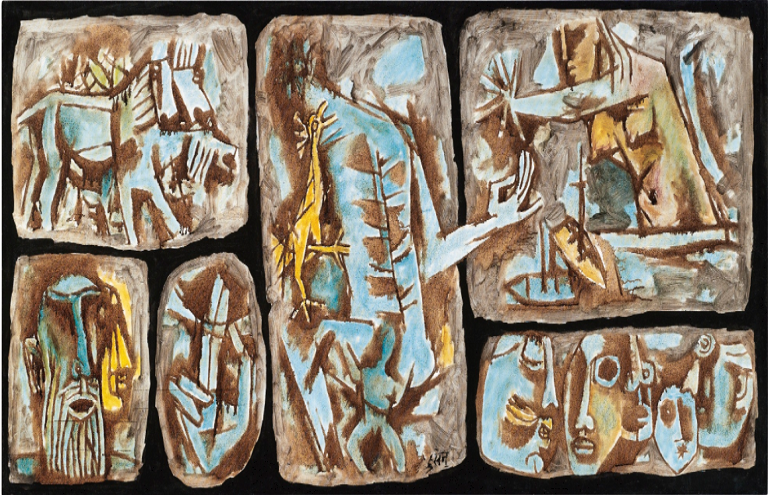
The Horses
Husain not only had a keen interest in painting the landscapes but was also fond of the wild animals, which is clearly evident in his horse painting. However, most of his works depict his eternal love for the horses, an animal regarded as a manifestation of dynamism and powerful energy in Indian mythology.
The excellent use of colors and typical strokes of Husain made this artwork grab significant attention from the audience worldwide. Popular with the name ‘The Horse that Looked Back’ in the global market, it was sold at Sotheby’s auction for 1.3 crores INR.
Tribute to Hashmi
Another painting by Husain where he fearlessly represents the truth about the fatal attack on the theatre artist, Safdar Hashmi. Highlighting the contemporary happenings of the society, this painting received its share of criticism as well as some great amount of appreciation from the people. ‘Tribute to Hashmi’ (image below) was sold for 4.4 crores INR in an Indian art gallery auction in Kolkata.
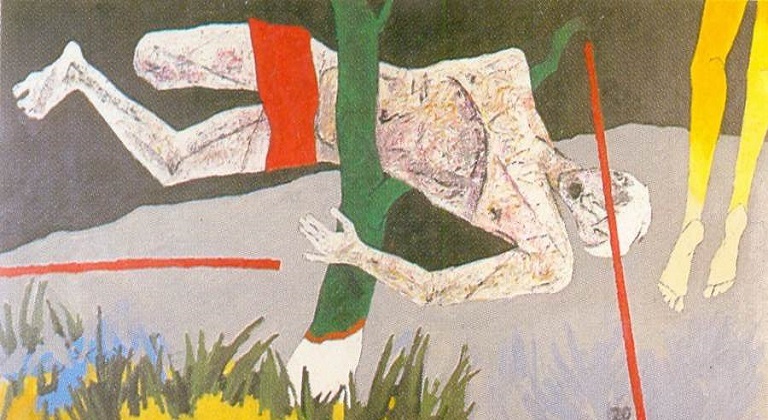
The Puppet Dancers:
One of the most popular paintings of Husain which fetched about 1.5 crore INR at Sotheby’s auction. Not many are aware of Husain’s love for toys, which he never missed an opportunity for manifesting in his creations. ‘The Puppet Dancers’ incorporates various elements including a woman, horse, dancer, warrior, etc. represented in his signature cubist art style. The distinctive bold strokes and brilliant color combinations made the painting one of its kinds in the entire world.
Bharatmata
One of the most popular artworks of Hussain which attracted criticism worldwide. He has manifested the map of India in the form of a nude lady along with many other related insignias. Though he never accorded any title to this painting, the nude portrayal aroused a lot of protests and strong criticism by many in the country.
Though Husain attempted to portray the hardships and struggles of the Indian motherland in the painting by employing dark hues of red and blue, it was the creation of the motherland as a nude figure that grabbed all the attention hailing Husain as delinquent.
